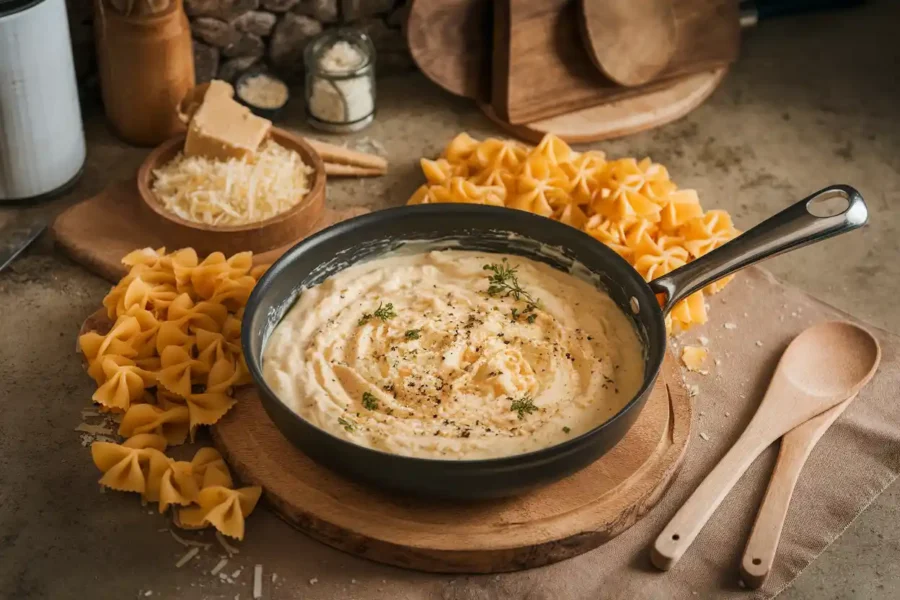When it comes to versatile cheeses, Fontina is a top contender. Its flavor, texture, and melting properties make it a favorite for chefs and home cooks alike. But what is the flavor of Fontina cheese? Is it sweet, tangy, buttery, or all of the above? In this article, we’ll explore the unique taste profile of Fontina cheese, how it enhances dishes, and why it’s a standout choice in the cheese world. Along the way, we’ll also compare it to similar cheeses, highlight key recipes, and answer common questions.
Table of Contents
Introduction to Fontina Cheese
What Is Fontina Cheese?
Fontina cheese is a semi-soft cheese originally from the Aosta Valley in Northern Italy. It has been crafted for centuries, and its reputation as a staple of Italian cuisine remains strong. Made from cow’s milk, Fontina is known for its creamy texture, pale yellow hue, and occasional small holes or “eyes.”
Its versatility is unmatched it can be eaten as is, melted into sauces, or paired with other ingredients for a flavorful twist. But what truly sets it apart is its distinct, nutty and buttery flavor, which adapts to a wide range of recipes.
Brief History and Origins of Fontina Cheese
Fontina traces its roots back to the 12th century in the Aosta Valley, where farmers used milk from cows grazing on alpine pastures. This pristine environment gave the cheese its characteristic richness and depth of flavor. Over time, Fontina cheese has expanded beyond Italy, with variations produced in Denmark, Sweden, and the United States. However, authentic Italian Fontina, labeled with the DOP (Protected Designation of Origin) mark, maintains its traditional taste and texture.
Understanding the history of Fontina provides a glimpse into why its flavor is so celebrated. The craftsmanship, quality of milk, and regional influences all play a role in creating this iconic cheese.
Flavor Profile of Fontina Cheese
Primary Taste Notes: Nutty, Buttery, and Tangy
So, what is the flavor of Fontina cheese? It’s a complex combination of nutty, buttery, and slightly tangy notes. Fresh Fontina offers a mild sweetness that balances beautifully with its creamy texture. As the cheese ages, the flavors deepen, revealing sharper and more earthy undertones. This unique mix makes it an excellent choice for both stand-alone enjoyment and as an ingredient in a variety of dishes.
Aging and Its Impact on Flavor
The aging process significantly influences Fontina’s taste. Young Fontina is soft and mild, with a fresh, milky flavor. In contrast, aged Fontina develops a firmer texture and a sharper, more robust taste. The aging adds complexity, enhancing the cheese’s nutty and slightly tangy qualities. This versatility allows it to complement a broad range of recipes, from creamy fondues to baked dishes.
Comparing Young and Aged Fontina Cheese
Younger Fontina works best in recipes that require a delicate, creamy texture, like sauces or risottos. Aged Fontina, however, shines in dishes needing a bolder flavor, such as gratins or paired with cured meats. Knowing which type to use is key to maximizing the cheese’s potential in your cooking.
Factors Contributing to Fontina’s Unique Flavor
Milk Type and Its Influence on Flavor
Fontina cheese owes much of its flavor to the high-quality cow’s milk used in its production. In traditional Italian Fontina, cows graze on alpine pastures, which infuse the milk with subtle floral and herbaceous notes. This natural diet translates into the cheese, giving it its characteristic richness and depth.
The Role of Production Techniques
The traditional methods of making Fontina contribute heavily to its unique taste. From the careful aging process to the use of unpasteurized milk, every step is designed to preserve and enhance the cheese’s natural flavor. Artisanal producers often age Fontina in caves, where the environment allows the flavors to develop fully.
Geographic Influence: Fontina from Italy vs. Other Regions
Authentic Italian Fontina carries a PDO (Protected Designation of Origin) status, ensuring it comes from the Aosta Valley. However, variations exist in Denmark, Sweden, and the U.S., each with subtle differences in flavor. While Italian Fontina leans towards nutty and tangy, its international counterparts often have milder, creamier profiles, showcasing how geography shapes taste.

How Fontina Cheese Enhances Dishes
Melting Properties and Flavor Integration
One of the standout qualities of Fontina cheese is its ability to melt beautifully. Whether used in fondues, pizzas, or creamy sauces, its buttery and nutty flavor pairs effortlessly with a variety of ingredients. The texture is smooth, with no separation or greasiness, making it an excellent choice for recipes requiring a seamless cheese blend.
For example, incorporating Fontina into a béchamel sauce elevates its richness, while using it on a pizza adds a unique depth of flavor. The gentle tang of Fontina enhances, rather than overpowers, the other ingredients, making every dish feel balanced and indulgent.
Best Recipes Showcasing Fontina’s Flavor
Recipes like baked ziti, risotto, and French onion soup are perfect showcases for Fontina. Its subtle sweetness complements the savory elements in these dishes, while its nutty undertones provide complexity. If you’re exploring new ways to use Fontina, try a classic fondue. This dish highlights the cheese’s creamy texture and distinct flavor.
Pairing Fontina Cheese with Other Ingredients
Fontina’s versatility extends beyond cooking; it pairs exceptionally well with wine, cured meats, and fresh fruits. Aged Fontina complements robust red wines, while younger Fontina pairs well with white wines or sparkling options. For a delightful cheese board, combine Fontina with prosciutto, figs, and crusty bread it’s a crowd-pleaser every time!
Similar Cheeses to Fontina
Cheeses with Comparable Flavor Profiles
If you’ve ever wondered what is the flavor of Fontina cheese compared to others, you’re not alone. Cheeses like Gruyère, Havarti, and Gouda share similar characteristics, making them great alternatives. Gruyère has a slightly sharper edge, while Havarti is milder and creamier. Gouda offers a sweet, nutty profile that mimics young Fontina beautifully.
Differences Between Fontina and Gruyère
Although Gruyère and Fontina are both celebrated melting cheeses, their flavors differ. Gruyère leans more towards a savory, earthy profile, while Fontina is creamier and nuttier. This distinction makes Fontina better suited for subtle dishes like risotto, whereas Gruyère works well in robust recipes like quiches or gratins.

Tips for Experimenting with Cheese Substitutes
Blending Different Cheeses for Unique Results
Mixing cheeses can help replicate Fontina’s signature flavor. For example, combining Mozzarella for its creaminess with Parmesan for its sharpness can create a well-rounded substitute. This blend is particularly useful in baked dishes where you want Fontina’s depth but need to adapt to available cheeses.
Adjusting Seasonings to Match Fontina’s Flavor
If your substitute lacks Fontina’s tang, you can add a splash of lemon juice or a hint of nutmeg to achieve a similar effect. These small tweaks help you recreate the nutty and tangy profile that defines Fontina, ensuring your recipes stay flavorful and balanced.
Using Non-Dairy Alternatives for Vegan Dishes
For plant-based dishes, nut-based cheeses made from cashews or almonds offer a creamy texture that mimics Fontina. Adding nutritional yeast can enhance the cheesy flavor, making it a great option for vegan fondues or creamy pastas. Experimenting with these substitutes lets you enjoy the essence of Fontina cheese in a dairy-free way.
These tips and tricks ensure that whether you’re using Fontina or experimenting with substitutes, your dishes will always be delicious and satisfying! Stay creative, and don’t hesitate to adapt recipes to suit your tastes and needs.
Conclusion: Understanding the Flavor of Fontina Cheese
A Unique Blend of Nutty, Buttery, and Tangy
To answer what is the flavor of Fontina cheese, it’s a delightful blend of nutty, buttery, and tangy notes that evolves with age. Whether young and mild or aged and robust, Fontina’s flavor is versatile and enhances a wide range of dishes. Its creamy texture and balanced taste make it a favorite for fondues, pasta, and cheese boards alike.
Why Fontina Stands Out
What makes Fontina truly special is its ability to complement both delicate and bold ingredients. From its alpine roots to its rich, complex taste, it’s a cheese that satisfies on every level. Experimenting with Fontina or its substitutes ensures you can enjoy its essence, no matter the recipe or occasion.
FAQs
How Does Fontina Cheese Taste When Cooked?
When cooked, Fontina’s creamy and nutty flavor becomes even richer. Its smooth melting properties make it perfect for sauces, baked dishes, and pizzas. The gentle tang intensifies slightly, blending seamlessly with other ingredients for a harmonious taste.
Is Fontina Suitable for Cheese Boards?
Absolutely! Fontina’s balance of buttery and nutty notes makes it a great addition to any cheese board. Pair it with prosciutto, figs, and crusty bread for a simple yet sophisticated presentation.
Can You Use Fontina Cheese for Grilling?
Yes, Fontina is excellent for grilling. Its creamy melt and mildly tangy flavor make it ideal for sandwiches and burgers, where it adds depth without overwhelming the dish.
What Are the Best Fontina Substitutes for Cooking?
Gruyère, Havarti, and Gouda are among the best substitutes for Fontina. They share similar nutty and creamy profiles, ensuring your recipes retain their richness and flavor.
What Can You Use in Place of Fontina Cheese?
If Fontina cheese isn’t available, there are plenty of substitutes that can deliver similar flavors and textures. Gruyère is one of the closest matches, offering a nutty and creamy taste. For milder recipes, Mozzarella or Havarti works well, while Gouda or Provolone can replicate the buttery richness of Fontina. These alternatives help answer the question, what is the flavor of Fontina cheese, by highlighting its versatility through comparable options.
Is Fontina the Same as Provolone?
While Fontina and Provolone share some similarities, they’re far from identical. Fontina boasts a more nutty and tangy flavor, while Provolone leans toward a milder, slightly smoky taste. Both melt beautifully, but Fontina’s richness makes it better suited for dishes like fondue or creamy sauces, while Provolone excels in sandwiches and pizzas.
What Is the Difference Between Fontina and Gruyère Cheese?
The key difference lies in the flavor profile: Gruyère is sharper and more savory, whereas Fontina is creamier and nuttier. Gruyère often has an earthy depth, making it ideal for quiches or gratins, while Fontina’s subtle tang is better for balanced dishes like risotto or pasta. Understanding these distinctions is vital when deciding which cheese to use in your recipes.
How Do You Use Fontina Cheese in Recipes?
Fontina’s versatility shines in both traditional and creative dishes. Melt it into sauces, layer it on pizzas, or bake it into casseroles for a touch of creamy, nutty flavor. It also pairs beautifully with fruits and wines for an elevated cheese board experience. If you’re wondering what is the flavor of Fontina cheese when cooked, it’s even richer, with its buttery and tangy notes blending seamlessly with other ingredients.
With these insights, you’re now equipped to appreciate and incorporate Fontina cheese into your culinary creations. Whether you’re savoring its unique taste or experimenting with substitutes, Fontina promises to elevate your dishes!

